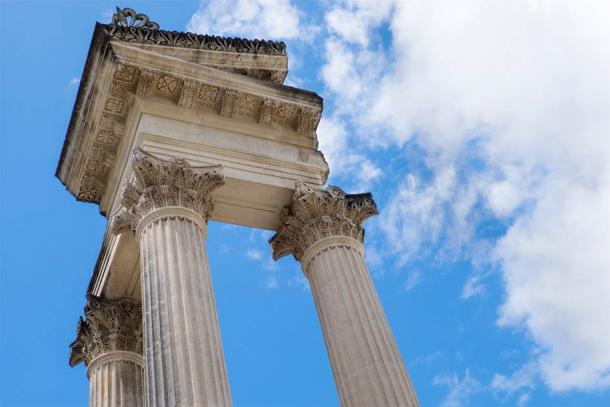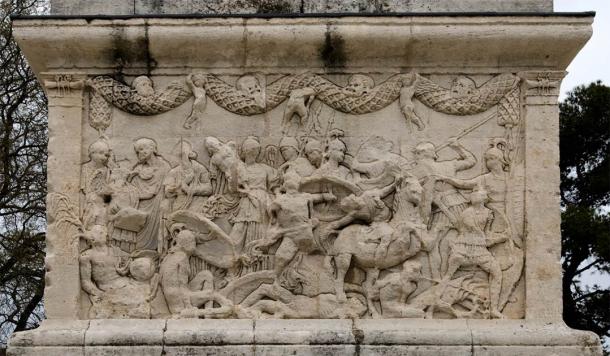We are fortunate to have access to many ancient Roman cities throughout the vast regions they once ruled. Their ruins tell us a great deal about their gods, their hobbies, their lifestyle, and their politics. Glanum, an ancient site located near the picturesque town of Saint-Rémy-de-Provence, southern France, is a beautiful testament to their achievements.
Although the site was originally a Celto-Ligurian settlement, it was expanded under the Hellenistic influence brought by Greek colonists who moved inland from Marseille. Later conquered by the Romans, the town flourished until it was abandoned during the 3rd century AD. Many of the ruins at the site date to the Roman period and not all have yet been revealed.
The Sacred and Healing Waters of Glanum
Glanum is situated in a narrow valley on the northern flank of the Alpilles, a low mountain range in Provence. Archaeological evidence suggests that these mountains were populated by humans as early as 2500 BC. It was only around the 7th century BC that Gallic tribes settled at the site. The nearby spring, believed to be sacred and have healing properties, would account for their choice. The waters retained their significance even after the arrival of the Gallic tribes.
In the centuries that followed, the settlement continued to develop and prosper. By the 2 nd century BC, the town had grown into an oppidum (a large, fortified Iron Age settlement) that was dominated by the Salyens, a Celto-Ligurian tribe. The town was in contact with the Greek world , especially with the Phocaean colony of Massalia (known today as Marseille). These contacts brought not only immense wealth to the town, but also the influence of Hellenistic culture.
Conflict Leading to the Roman Rule
By the 2 nd century AD, conflicts broke out between the Salyens and Massalia. The latter, lacking a strong army, appealed to their Roman allies for help. The Salyens were defeated and life continued as normal until the ‘Romanization’ of the town which began in the 1 st century BC. It was under Roman rule that the town became known as Glanum. This name is derived from Glan, or Glanis, a Celtic god, and the Glanicae, the mother-goddesses similar to the female Roman deities, the Matres. These deities were believed to inhabit waters that have healing properties, such as the spring around which the town developed.

Ruins of the Temple of Valetudo. Glanum, fortified Roman town in Provence. ( emily_m_wilson / Adobe Stock)
Although Glanum lost its independence, it prospered further under Roman rule. The construction of the Via Domitia , the first Roman road built in Gaul, benefitted not only the town, but the entire region as it connected Italy and Spain via Gallia Narbonensis (today the southern part of France). The new road brought numerous travellers to Glanum, by then a religious sanctuary built around the sacred spring.
During the reign of Augustus, Glanum first became a colonia, and was then given the status of a city. Glanum became one of the leading centres of Roman civilisation to the west of the Alps. Unfortunately, the prosperity did not last forever. During the 3 rd century AD, Glanum fell victim to the Germanic tribes who invaded the area, and the town was abandoned in 260 AD.
The Unique Finds at Glanum and Those Still to be Discovered
Despite the fall of Glanum and its subsequent abandonment, a number of its Roman structures were saved from destruction and can still be seen today. The most famous of these are ‘Les Antiques’, which consist of the Jules Mausoleum and a triumphal arch . For a long time, these were the only two Roman monuments visible at the site and they stand proudly at the entrance of the ancient town. Not only are they the best-known Roman monuments at Glanum, but they are also two of the most famous in Provence.

Detail of the Jules Mausoleum in Glanum ( Jorge Alves / Adobe Stock)
The Jules Mausoleum, a funerary monument belonging to the local elites Julii family, was constructed between 30 and 20 BC. It is believed that the monument was dedicated to the parents of the three Julii brothers, Sextius, Marcus, and Lucius. In addition to its excellent state of preservation, the mausoleum is architecturally different from most other examples of Roman mausoleums. The lowest part of the mausoleum is decorated with vegetation, theatre masks and cupids with mythical or legendary scenes. The middle stage is an arch with four bays. The carved head of a gorgon, the traditional protector of Roman tombs, sits at the top of each arch. The upper portion holds a circular chapel with Corinthian columns and houses two statues wearing togas, presumably the father and grandfather of the Julii. Finally, the conical roof is decorated with fish scales, traditional for Roman mausoleums.
The triumphal arch dates to 20 AD and is most notable for the bas reliefs depicting the conquest of Gaul by Julius Caesar. Incidentally, the monument’s pediment was lost at some point in time, and the present roof dates to the 18 th century. The Jules Mausoleum and the triumphant arch are both evidence of Glanum’s prosperity under Roman rule.
During the 19 th century, further archaeological excavations were carried out at the site, uncovering more remnants of Glanum’s glorious past. These include the two Roman forums, the Roman baths , temples, and residences. To date only a small part of the site has been excavated, and it is likely that there are more remains to be found. Excavations are being carried out by the Institute for Research in Ancient Architecture.
Visiting the ancient Roman City of Glanum
Glanum is a tourist attraction open to the public. The site is located about a kilometre (0.62 mi) south of Saint-Rémy-de-Provence, and there is an entrance fee to the site. The site maintains a Twitter account, @GlanumSade, where the latest news (in French) about the site can be found.
Top image: Triumphal Arch and Jules Mausoleum. Roman ruins, entrance of ancient Roman city of Glanum, Saint-Remy-de-Provence, France. Source: Feel good studio / Adobe Stock
By Wu Mingren
Related posts:
Views: 0
 RSS Feed
RSS Feed

















 December 31st, 2020
December 31st, 2020  Awake Goy
Awake Goy  Posted in
Posted in  Tags:
Tags: 
















